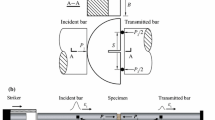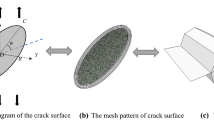Abstract
The semicircular specimen under three-point bending (SCB) has been widely used to investigate mode I, mode II, and mixed mode I/II fracture behavior in brittle rocks. Compared to the other numerical methods, the extended finite element method (X-FEM) models a crack independently of the finite element mesh without any remeshing step in fracture propagation. In this regard, a numerical code called MEX-FEM, based on X-FEM, has been developed for modeling crack propagation in rock material. Since dimensionless stress intensity factors (i.e., Y I and Y II) in crack modeling of SCB specimen depend on crack length, crack angle, and span ratio, these factors and crack propagation trajectory are determined for different combinations of crack angle, crack length ratio, and span ratio. A very good agreement exists between the calculated factors Y I and Y II in this research work and those reported in the literature. The results show that the values of Y I and Y II increase by increasing the span ratio. The angle in which the pure mode II occurs decreases with increasing of the crack length ratio and it increases when the span ratio increases. The crack growth is along the initial crack when the specimen is subjected to pure mode I (i.e., the crack angle is 0), whereas in mixed mode, the crack is deviated toward the upper loading point. The results of this study demonstrate the utility and robustness of the X-FEM to simulate the crack growth in rock materials.















Similar content being viewed by others
Abbreviations
- A :
-
Crack length
- A ω :
-
Nodal support area
- A aboveω :
-
Nodal support area above the crack
- A belowω :
-
Nodal support area below the crack
- a j :
-
Additional degrees of nodal freedom associated with the Heaviside function
- b l k :
-
Additional degrees of nodal associated with the elastic asymptotic crack tip functions
- CB:
-
Chevron edge-notched round bar in bending
- CCBD:
-
Central cracked Brazilian disk under diametric compression
- D :
-
Diameter of specimen
- H :
-
Modified Heaviside step function
- I :
-
Set of all nodes in the mesh
- I (1,2) :
-
Interaction integral
- J :
-
Set of nodes enriched with discontinuous enrichment
- K :
-
Set of nodes enriched with asymptotic enrichment
- K I :
-
Stress intensity factor mode I
- K II :
-
Stress intensity factor mode II
- N(x):
-
Shape function
- P :
-
Compressive applied load
- R :
-
Radius of specimen
- r, θ :
-
Crack tip coordinates
- S :
-
Half span length
- SCB:
-
Semicircular bend
- SIF:
-
Stress intensity factor
- SR:
-
Chevron-notched short rod
- t :
-
Thickness of specimen
- u i :
-
Nodal displacement
- U x :
-
Horizontal displacement
- W (1,2) :
-
Interaction strain energy
- X-FEM:
-
Extended finite element method
- Y I :
-
Dimensionless stress intensity factor mode I
- Y II :
-
Dimensionless stress intensity factor mode II
- α :
-
Crack angle
- θ c :
-
Crack initiation angle
- Δa :
-
Crack length increment
References
Aliha M, Ayatollahi M (2011) Mixed mode I/II brittle fracture evaluation of marble using SCB specimen. Proc Eng 10:311–318
Aliha M, Ayatollahi M (2013) Two-parameter fracture analysis of SCB rock specimen under mixed mode loading. Eng Fract Mech 103:115–123
Atkinson C, Smelser R, Sanchez J (1982) Combined mode fracture via the cracked Brazilian disk test. Int J Fract 18:279–291
Awaji H, Sato S (1978) Combined mode fracture toughness measurement by the disk test. J Eng Mater Technol 100:175
Ayatollahi M, Aliha M (2006) On determination of mode II fracture toughness using semi-circular bend specimen. Int J Solids Struct 43:5217–5227
Ayatollahi M, Aliha M (2007) Wide range data for crack tip parameters in two disc-type specimens under mixed mode loading. Comput Mater Sci 38:660–670
Ayatollahi M, Aliha M, Hassani M (2006) Mixed mode brittle fracture in PMMA—an experimental study using SCB specimens. Mater Sci Eng A 417:348–356
Ayatollahi M, Aliha M, Saghafi H (2011) An improved semi-circular bend specimen for investigating mixed mode brittle fracture. Eng Fract Mech 78:110–123
Belytschko T, Black T (1999) Elastic crack growth in finite elements with minimal remeshing. Int J Numer Methods Eng 45:601–620
Belytschko T, Gracie R, Ventura G (2009) A review of extended/generalized finite element methods for material modeling. Model Simul Mater Sci Eng 17:043001
Chahine E, Laborde P, Renard Y (2008) Crack tip enrichment in the XFEM using a cutoff function. Int J Numer Methods Eng 75:629–646
Chang S-H, Lee C-I, Jeon S (2002) Measurement of rock fracture toughness under modes I and II and mixed-mode conditions by using disc-type specimens. Eng Geol 66:79–97
Chong K, Kuruppu M (1984) New specimen for fracture toughness determination for rock and other materials. Int J Fract 26:R59–R62
Chong KP, Kuruppu MD (1988) New specimens for mixed mode fracture investigations of geomaterials. Eng Fract Mech 30:701–712
Chong KP, Kuruppu MD, Kuszmaul JS (1987) Fracture toughness determination of layered materials. Eng Fract Mech 28:43–54
Dai F, Chen R, Xia K (2010) A semi-circular bend technique for determining dynamic fracture toughness. Exp Mech 50:783–791
Dolbow JE (1999) An extended finite element method with discontinuous enrichment for applied mechanics. PhD thesis, Northwestern University
Eftekhari M, Baghbanan A, Hashemolhosseini H (2014) Determining stress intensity factor for cracked Brazilian disc using extended finite element method. Int J Sci Eng Technol 3:890–893
Erdogan F, Sih G (1963) On the crack extension in plates under plane loading and transverse shear. J Basic Eng 85:519
Fleming M, Chu Y, Moran B, Belytschko T, Lu Y, Gu L (1997) Enriched element-free Galerkin methods for crack tip fields. Int J Numer Methods Eng 40:1483–1504
Kuruppu M, Obara Y, Ayatollahi M, Chong K, Funatsu T (2014) ISRM-suggested method for determining the mode I static fracture toughness using semi-circular bend specimen. Rock Mech Rock Eng 47:267–274
Kuruppu MD, Chong KP (2012) Fracture toughness testing of brittle materials using semi-circular bend (SCB) specimen. Eng Fract Mech 91:133–150
Lancaster I, Khalid H, Kougioumtzoglou I (2013) Extended FEM modelling of crack propagation using the semi-circular bending test. Constr Build Mater 48:270–277
Lim I, Johnston I, Choi S (1993) Stress intensity factors for semi-circular specimens under three-point bending. Eng Fract Mech 44:363–382
Mahmoud E, Saadeh S, Hakimelahi H, Harvey J (2014) Extended finite-element modelling of asphalt mixtures fracture properties using the semi-circular bending test. Road Mater Pavement Des 15:153–166
Moës N, Dolbow J, Belytschko T (1999) A finite element method for crack growth without remeshing. Int J Numer Methods Eng 46:131–150
Mohammadi S (2008) Extended finite element method: for fracture analysis of structures. Wiley, Chichester
Nuismer R (1975) An energy release rate criterion for mixed mode fracture. Int J Fract 11:245–250
Richardson CL, Hegemann J, Sifakis E, Hellrung J, Teran JM (2011) An XFEM method for modeling geometrically elaborate crack propagation in brittle materials. Int J Numer Methods Eng 88:1042–1065
Shetty DK, Rosenfield AR, Duckworth WH (1987) Mixed-mode fracture in biaxial stress state: application of the diametral-compression (Brazilian disk) test. Eng Fract Mech 26:825–840
Sih GC (1974) Strain-energy-density factor applied to mixed mode crack problems. Int J Fract 10:305–321
Stazi F, Budyn E, Chessa J, Belytschko T (2003) An extended finite element method with higher-order elements for curved cracks. Comput Mech 31:38–48
Sukumar N, Prévost J-H (2003) Modeling quasi-static crack growth with the extended finite element method. Part I: computer implementation. Int J Solids Struct 40:7513–7537
Whittaker BN, Singh RN, Sun G (1992) Rock fracture mechanics. Elsevier, Amsterdam
Zhou Y et al (2012) Suggested methods for determining the dynamic strength parameters and mode-I fracture toughness of rock materials. Int J Rock Mech Min Sci 49:105–112
Author information
Authors and Affiliations
Corresponding author
Rights and permissions
About this article
Cite this article
Eftekhari, M., Baghbanan, A. & Hashemolhosseini, H. Fracture propagation in a cracked semicircular bend specimen under mixed mode loading using extended finite element method. Arab J Geosci 8, 9635–9646 (2015). https://doi.org/10.1007/s12517-015-1906-4
Received:
Accepted:
Published:
Issue Date:
DOI: https://doi.org/10.1007/s12517-015-1906-4




